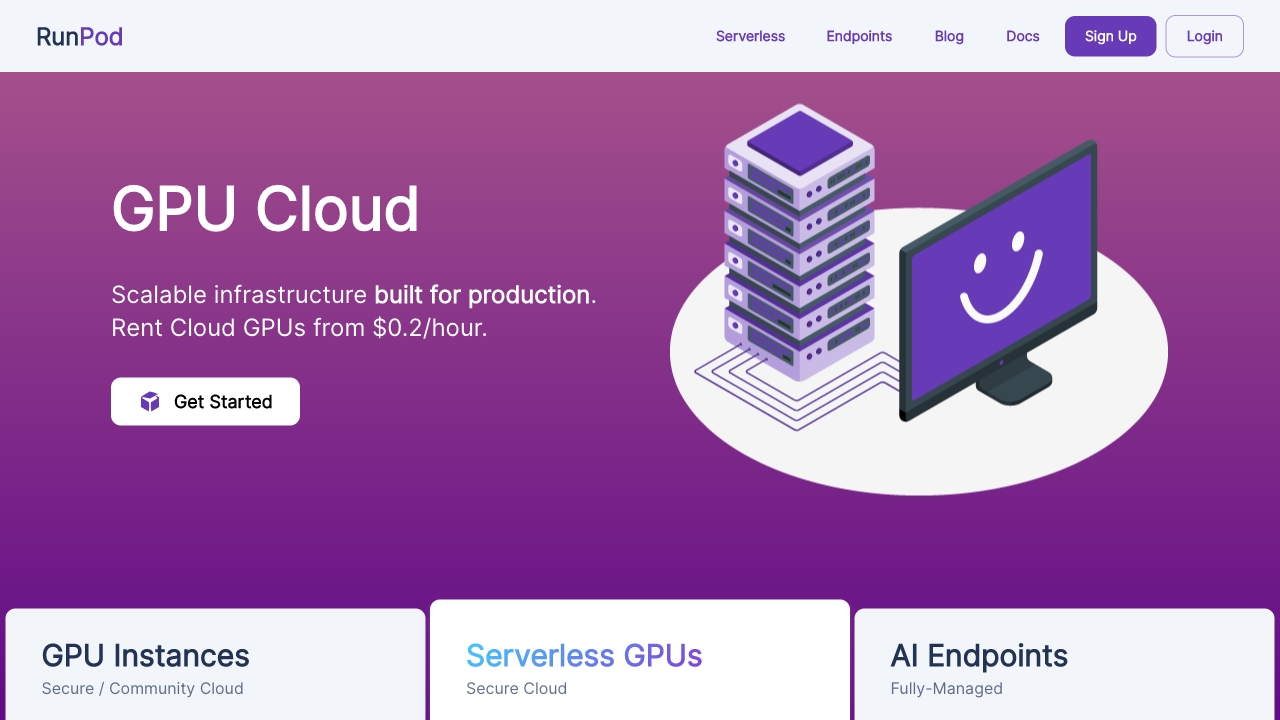
RunPod
Open Website-
Tool Introduction:Comet by Perplexity: AI browser for fast answers, summaries, and flow.
-
Inclusion Date:Oct 21, 2025
-
Social Media & Email:
Tool Information
What is RunPod AI
RunPod AI is a GPU cloud built for machine learning development, training, and inference at any scale. It offers on-demand GPU instances (“pods”), serverless endpoints for low-latency inference, and ready-to-use workspaces such as Jupyter for PyTorch and TensorFlow. Users can launch isolated containers in minutes, attach persistent volumes, and pay only for the compute they consume. By combining flexible provisioning with a simple API, templates, and monitoring, RunPod helps startups, academics, and enterprises accelerate experiments and reduce infrastructure overhead.
RunPod AI Main Features
- On-demand GPU pods: Provision containerized GPU instances in minutes; choose GPU class, vRAM, CPU, and memory to match training or fine-tuning needs.
- Serverless inference: Deploy models as autoscaling endpoints; pay only for active compute time while handling concurrent requests via a simple API.
- Ready-to-use workspaces: Launch JupyterLab or similar environments preconfigured for PyTorch and TensorFlow to start coding immediately.
- Templates and images: Start from curated templates or bring your own Docker image for reproducible environments and faster setup.
- Persistent storage: Attach volumes to save datasets and checkpoints; restart pods without losing progress.
- Networking and access: Connect via secure URLs, SSH, or port forwarding; expose services for testing and integration.
- API and automation: Use REST APIs or SDKs to script provisioning, CI/CD, batch jobs, and MLOps workflows.
- Cost control and monitoring: Track usage, set auto-shutdown, and right-size resources to optimize GPU spend.
- Flexible infrastructure options: Mix cost-optimized community GPUs with enterprise-grade secure environments based on compliance needs.
Who Should Use RunPod AI
RunPod AI suits ML engineers, data scientists, and researchers who need scalable GPUs without managing hardware. It fits startups exploring rapid experiments, academics running coursework or papers, indie developers prototyping models, and product teams deploying serverless inference for computer vision, NLP, or recommendation systems. It also supports teams needing reproducible containers and persistent storage for collaborative projects.
RunPod AI Usage Steps
- Create an account and set up billing or credits.
- Choose a region, GPU type, and resource profile (GPU/CPU/RAM).
- Select a workspace template (e.g., Jupyter with PyTorch/TensorFlow) or provide your own Docker image.
- Configure environment variables, ports, and a persistent volume size for datasets and checkpoints.
- Launch the pod and connect via the Jupyter URL, SSH, or a remote IDE.
- Load data into the attached volume or connect to external object storage; install any extra dependencies.
- Train or fine-tune models, monitor GPU/CPU usage and logs, and save checkpoints regularly.
- Snapshot the environment if needed, and stop or auto-shutdown the pod to control costs.
- For production, package your model as a serverless endpoint, define the handler, deploy, and test with the REST API.
- Integrate the endpoint into your app, set concurrency/autoscaling, and monitor latency, throughput, and cost.
RunPod AI Industry Use Cases
A computer vision startup trains detection models on on-demand GPUs, then serves predictions via serverless inference to handle variable traffic. A research lab runs large hyperparameter sweeps using multiple pods in parallel, persisting results to shared volumes for reproducibility. An enterprise team fine-tunes language models in a controlled environment and exposes internal APIs for analytics workloads, scaling capacity during peak demand without long-term hardware commitments.
RunPod AI Pricing
RunPod AI uses a pay-as-you-go model: you pay for GPU compute time based on the selected GPU class and region, plus optional charges for persistent storage and data egress. Serverless endpoints are typically billed by request duration and allocated resources. Teams can purchase credits and configure usage limits; enterprise options are available for dedicated capacity and consolidated billing.
RunPod AI Pros and Cons
Pros:
- Fast, flexible access to on-demand GPUs without managing hardware.
- Serverless endpoints for low-latency, autoscaling model inference.
- Ready-to-use Jupyter workspaces for PyTorch and TensorFlow.
- Persistent storage for datasets and checkpoints; reproducible environments via Docker.
- API/SDK support for automation, CI/CD, and MLOps pipelines.
- Cost controls with right-sizing, auto-shutdown, and usage monitoring.
Cons:
- GPU availability and pricing can vary by region and demand.
- Serverless cold starts may affect tail latency for infrequent workloads.
- Custom Docker images and scaling strategies require DevOps familiarity.
- Data egress and persistent storage add to total cost for large datasets.
- Strict compliance needs may require selecting specific secure environments.
RunPod AI FAQs
-
Can I bring my own Docker image?
Yes. You can launch pods from a custom container image to ensure reproducible dependencies and tooling.
-
Does RunPod support PyTorch and TensorFlow?
Yes. Prebuilt workspaces include Jupyter with common ML stacks like PyTorch and TensorFlow so you can start training quickly.
-
How does serverless inference work?
You package a model and handler, deploy as an endpoint, and invoke it via a REST API. The platform scales concurrency and bills for active compute time.
-
Will my data persist when I stop a pod?
If you attach a persistent volume, data such as datasets and checkpoints remain available across restarts. Ephemeral storage is cleared when a pod stops.
-
What kinds of GPUs are available?
A range of consumer and data center GPUs are typically offered, with pricing and availability varying by region and capacity.




